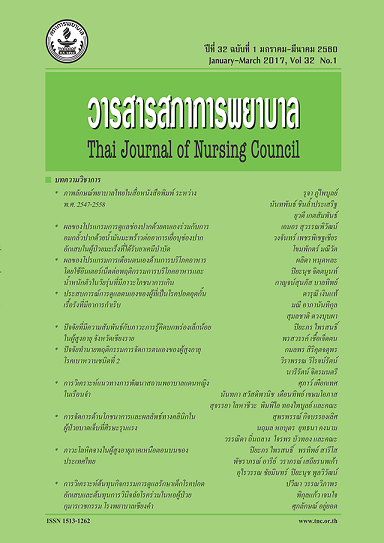การวิเคราะห์ต้นทุนกิจกรรมการดูแลรักษาเด็กโรคปอดอักเสบและต้นทุน การวินิจฉัยโรคร่วมในหอผู้ป่วยกุมารเวชกรรม โรงพยาบาลเชียงคำ
Keywords:
ต้นทุนกิจกรรม, การดูแลรักษา, ต้นทุนการวินิจฉัยโรคเด็กโรคปอดอักเสบ, activity-based costing, diagnosis-related group costing, child pneumonia patientsAbstract
วัตถุประสงค์: เพื่อศึกษาความแตกต่างระหว่างต้นทุนกิจกรรมการดูแลรักษากับต้นทุน
การวินิจฉัย โรคร่วมในเด็กโรคปอดอักเสบ หอผู้ป่วยกุมารเวชกรรม โรงพยาบาลเชียงคำ
รูปแบบการวิจัย: การวิจัยเชิงบรรยาย
วิธีดำเนินการวิจัย; ประชากรที่ศึกษา คือ ทีมเจ้าหน้าที่ที่ดูแลรักษาเด็กป่วยโรคปอดอักเสบ
ทั้งหมดจำนวน 25 คน และเด็กป่วยโรคปอดอักเสบที่เข้ารับการรักษาในหอผู้ป่วยกุมารเวชกรรม
โรงพยาบาลเชียงคำ ระหว่างพฤษภาคม ถึงสิงหาคม 2559 ประชากรทั้งหมดจำนวน 39 คน ใช้
ขนาดตัวอย่าง จำนวน 14 คน กลุ่มตัวอย่างเลือกแบบเจาะจง เครื่องมือที่ใช้ในการวิจัย มี 6 ชุด คือ
ชุดที่ 1 แบบบันทึกข้อมูลทั่วไปของเด็กป่วย ชุดที่ 2 พจนานุกรมกิจกรรมการดูแลรักษาจำนวน 5
กิจกรรมหลัก ชุดที่ 3 แบบสังเกตเวลาที่ใช้ในการทำกิจกรรม ชุดที่ 4 แบบบันทึกข้อมูลการจัดบริการ
เด็กป่วยโรคปอดอักเสบ ชุดที่ 5 แบบบันทึกต้นทุน และชุดที่ 6 แบบบันทึกข้อมูล ตรวจสอบความตรง
ด้านเนื้อหาโดยผู้ทรงคุณวุฒิจำนวน 3 ท่าน และได้ค่าดัชนีความตรงตามเนื้อหา เท่ากับ .96 ใช้สถิติ
เชิงพรรณนา ได้แก่ การแจกแจงความถี่ ร้อยละ และค่าเฉลี่ย
ผลการวิจัย: พบว่า ต้นทุนกิจกรรมการดูแลรักษารวมสำหรับผู้ป่วยเด็กโรคปอดอักเสบโดย
ไม่คิดรวมค่ายา ค่าตรวจวินิจฉัย ค่าห้อง ค่าอาหารและค่าสาธารณูปโภค ต่อราย เท่ากับ 1,765.22 บาท
กิจกรรมที่มีต้นทุนสูงที่สุด คือ กิจกรรมการพยาบาลต่อเนื่อง เท่ากับ 855.15 บาท (ร้อยละ 48)
กิจกรรมที่มีต้นทุนตำ่ที่สุด คือ กิจกรรมของทีมสหสาขาวิชาชีพ เท่ากับ 140.69 บาท (ร้อยละ 13)
และพบว่าต้นทุนกิจกรรมการดูแลรักษา (ABC) ต่อราย โดยคิดรวมค่ายา ค่าตรวจวินิจฉัย ค่าห้อง/
ค่าอาหาร และค่าสาธารณูปโภค เท่ากับ 4,617.87 บาท บาท การวิจัยนี้พบว่า ความแตกต่างระหว่าง
ต้นทุนกิจกรรมการดูแลรักษาตำ่กว่าต้นทุนการวินิจฉัยตามกลุ่มโรค (DRG) เฉลี่ยต่อรายเท่ากับ
5,047.61 บาท
ข้อเสนอแนะ: ผู้บริหารควรนำเสนอผลการวิจัยให้บุคลากรในหน่วยงานได้ทราบเพื่อให้เกิด
ความตระหนักในการลดต้นทุนในการทำกิจกรรมโดยการคิดมาตรการ นวัตกรรม หรือนำเทคโนโลยี
สารสนเทศมาใช้ในงานเอกสารเพื่อลดต้นทุนและลดเวลาในกิจกรรมการดูแลรักษา
Objective: To study the differences between activity-based costing and diagnosis-related group costing for the treatment of children diagnosed with pneumonia at in the paediatric ward of Chiangkham Hospital.
Design: Descriptive research.
Procedure: The sample consisted of two groups: 25 staff members caring for child
pneumonia patients and 14 purposively sampled child pneumonia patients out of a total of 39
who were treated in the paediatric ward of Chiangkham Hospital between May and August
2016. Six instruments were used: (i) a form for recording the patients’ general information;
(ii) a treatment diary for 5 main activities; (iii) an activity time observation form; (iv) a
service record for the child pneumonia patients; (v) a costing record; and (vi) a data-recording form. The instruments were subjected to a content-validity check by 3 experts and obtained a validity score of .96. The data were analysed using descriptive statistics, in terms of
frequency distribution, percentage and mean.
Results: The average total treatment cost of treating each child pneumonia patient,
excluding the costs of medication, examination, room, meals and facilities, was THB
1,765.22. The highest-cost treatment activity per patient was the long-term nursing care,
averaging THB 855.15 (48%), whilst the lowest-cost treatment activity was the activities
performed by the multidisciplinary team, averaging THB 140.69 (13%). The average ABC
per case, inclusive of the costs of medication, examination, room, meals and facilities, was
THB 4,617.87, which was lower than the per-case DRG average of THB 5,047.61.
Recommendations: It is suggested that hospital administrators present this study’s
fndings to their personnel to increase their awareness that up-to-date measures, innovations
or technologies could be applied to their activities and documentation system as potential
cost-cutting alternatives.








